Ukuleles of various size and pricing are available at the Polynesian Cultural Center. We find many people seeking advice on choosing their ukulele. For those of you who can’t come personally, our online outlet, The Hawaii Store, also provides many options. To help you choose the perfect ukulele for you, we wanted to share our advice for our most common questions.
Rebecca Sabalones points out some key information to consider here:
Wood
Koa is the highest-end wood that comes from Hawaii. It is beautiful to look at and listen to. A lot of value is put into the grade of the koa wood, which is determined by how close to the bottom of the tree you are. The wood that is closer to the bottom of the tree has a higher grade because it has withstood the effect of Hawaiian trade winds longer. The wind blows the tree back and forth which results in a curly or wavy grain.
Acacia is in the same tree family as koa and is also a hard wood that is affordable and long lasting.
Mahogany is another affordable option and has a beautiful warm sound.
Spruce has a lighter and brighter sound.
There are several other great wood options as well, including cedar, redwood, and maple. Most ukuleles are layered with a laminate of one of these woods to keep it from warping and sounding strange.
To see the different types of wood used in ukuleles in our online store, click on the following:
Size
The four progressive ukulele sizes are soprano, concert, tenor, and baritone. As the size of the ukulele gets bigger, the sound gets deeper.
People often take their own body shape/size and sound preference into account when choosing their ukulele.
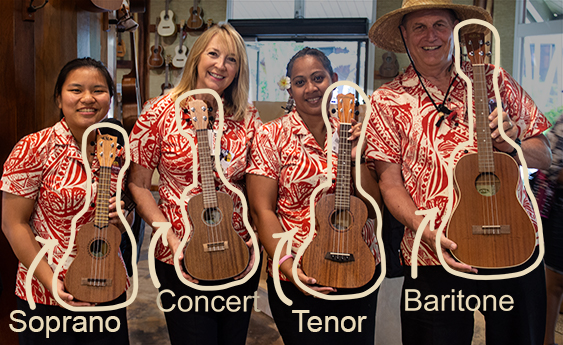
Ukulele sizes include soprano, concert, tenor, and baritone
Note: if you’re considering a baritone, be aware the strings are tuned B-D-G-E (as opposed to G-C-E-A). Most people start out on either a soprano or concert size.
To watch a brief overview of ukulele size sounds from Austin Bazaar, click here.
Gloss vs. Satin
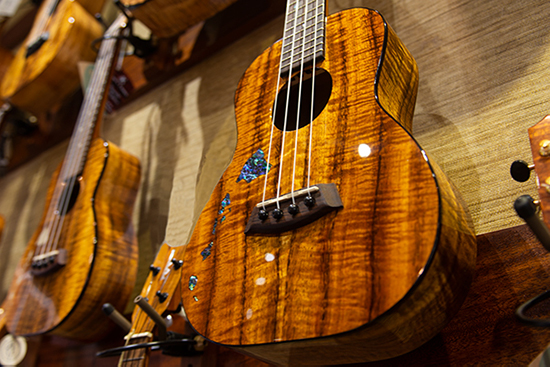
Glossed Kanile’a koa ukulele with abalone (or paua) shell inlay of Hawaiian islands. Photo by Rebecca Sabalones
Gloss will make an ukulele look top of the line, however, it does muffle the sound a bit. Another issue with the gloss is that it’s easy to leave fingerprints. That said, a gloss brings out the brilliant colors and textures in the wood and gives it a professional finish.
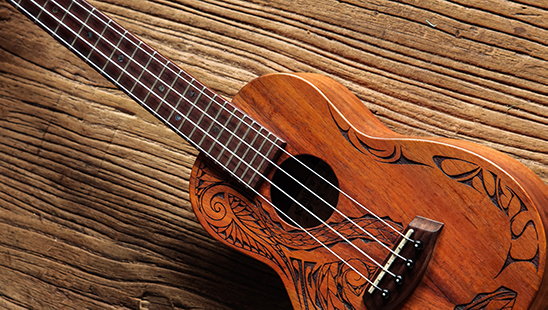
Satin finish ukulele with polynesian tattoo carvings
A satin finish both protects the ukulele and allows the sound to resonate. The finish is applied to the ukulele to fill in the pores, which helps to keep the ukulele from being damaged by environmental conditions.
Strings
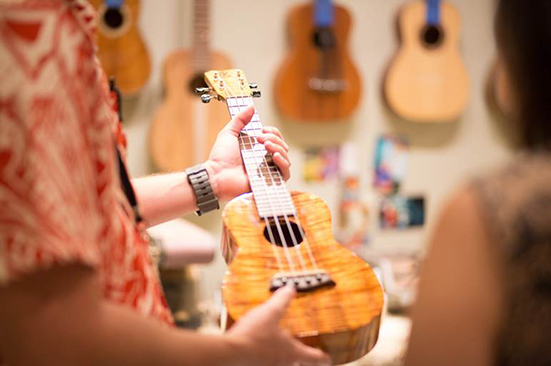
Worker at the Polynesian Cultural Center showcasing a Kanile’a koa ukulele
The primary material for ukulele strings is nylon or nylgut, giving it that classic, bright ukulele sound.
A few strings are made with metal, which gives the notes a sharper guitar sound.
A more rare and expensive type of string is gut, which is made of sheep skin, and has a tendency to grow loose in a shorter period of time.
Note: an option to consider is the octave difference of high G or low G for your first string (most common tuning is high G). Check out a review of high G and low G by Hawaii Music Supply.
We suggest one of the following brands for quality and affordability:
The ukulele in Hawaii
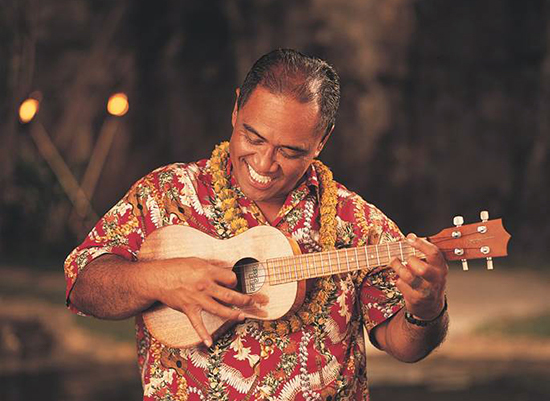
The late Benny Kai, a favorite performer and Master of Ceremonies at the Center, was also a master of the ukulele
The first version of ukulele was introduced to Hawaii when Portuguese immigrants brought the four-stringed machete de braga in 1879. Three cabinetmakers in that group—Augusto Dias, Manuel Nunes and Jose do Espirito Santo—opened instrument shops in Honolulu by 1886 and the small Portuguese ‘guitars’ started to grow in popularity.
King Kalakaua, Hawaii’s “Merrie Monarch”, learned to play and make the instrument, turning it forever into the Hawaiian ukulele. One of King Kalakaua’s short English officers, Edward William Purvis, was nicknamed “Ukulele” because his fingers seemed to fly when he played, and some attribute the nickname given to the instrument.
Uku in Hawaiian means flea, and lele means to jump or fly. To pronounce it properly, sound it out ooo-koo-lay-lay (not yuka-lay-lee!)
The popularity of the ukulele was spread around the world by various groups and artists, including Ernest Kaai, Roy Smeck, Bing Crosby, participants in The Hawaiian Pavilion, the Beatles and Elvis Presley.
One of the biggest ukulele stars was none other than Hawaii’s own, the late Israel “Braddah IZ” Kamakawiwoole. His 1993 reggae-influenced rendition of Over the Rainbow and What a Wonderful World became a mega hit used in films, TV programs and commercials.
To check out albums of some of these famous arts go to shop.polynesia.com.
Learn how to play!
One could always stop by the Polynesian Cultural Center for a free lesson, but if you are off-island, we have two good online recommendations—YouTube and Google! We like the teaching styles of UkuLenny and Cynthia Lin J.
Click to learn Stand By Me or I Lava You from the Pixar short-film Lava.
Also, check out an easy-to-use chord chart from TrueFire.com.

Rebecca Sabalones is a published writer and editor from Indiana. She graduated with a B.A. in Cultural Communications from Brigham Young University–Hawaii, worked as a multi-media journalist and editor-in-chief for Ke Alaka’i, taught English in Taiwan, and worked as a copy editor for The Daily Herald. The islands called her back to Hawaii where she has been occupied with sales and marketing for the Polynesian Cultural Center.



It was Manuel Nunes, not Junes. He was my great great grandfather.
Thank you for catching that! You have an amazing heritage 🙂